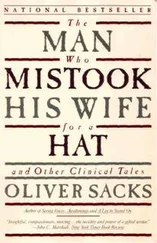I was about eleven, in bed with a high fever, when I heard some heavenly music. I understood it to be a choir of angels, even though I found this odd, as I don’t believe in heaven or angels and never have. So I decided it must be coming from Christmas carolers on our front doorstep below. After a minute or so, I realized it was springtime, and that I must be hallucinating.
A number of people have written to me that they have visual hallucinations of music, hallucinating musical notation all over the walls and ceiling. One of them, Christy C., recalled:
As a child, I ran high fevers when sick. With each spell, I would hallucinate. This was an optical hallucination involving musical notes and stanzas. I did not hear music. When the fever was high, I would see notes and clef lines, scrambled and out of order. The notes were angry and I felt unease. The lines and notes were out of control and at times in a ball. For hours, I would try to mentally smooth them out and put them in harmony or order. This same hallucination has plagued me as an adult when feverish.
Tactile hallucinations, too, can come with fever or delirium, as Johnny M. described: “When I had high fevers as a child I had very weird tactile hallucinations … a nurse’s fingers would switch from being beautiful smooth porcelain to rough, brittle-feeling twigs or my bed sheets would go from luscious satin to drenched, heavy blankets.”
Fevers are perhaps the commonest cause of delirium, but there may be a less obvious metabolic or toxic cause, as recently happened with a physician friend of mine, Isabelle R. She had had two months of increasing weakness and occasional confusion; finally she became unresponsive and was taken to the hospital, where she had a florid delirium, with hallucinations and delusions. She was convinced that a secret laboratory was hidden behind a picture on the wall of her hospital room — and that I was supervising a series of experiments on her. She was found to have extremely high levels of calcium and vitamin D (she had been taking large doses of these for her osteoporosis), and as soon as these toxic levels dropped, her delirium ceased, and she returned to normal.
Delirium is classically associated with alcohol toxicity or withdrawal. Emil Kraepelin, in his great 1904 Lectures on Clinical Psychiatry , included the case history of an innkeeper who developed delirium tremens from drinking six or seven liters of wine a day. He became restless and immersed in a dreamlike state in which, Kraepelin wrote,
particular real perceptions … are mingled with numerous very vivid false perceptions, especially of sight and hearing. As in a dream, a whole series of the most strange and remarkable events take place with occasional sudden changes of scene.… Given the vivid hallucinations of sight, the restlessness, the strong tremors, and the smell of alcohol, we have all the essential features of the clinical condition called delirium tremens .
The innkeeper had some delusions, too, perhaps produced by his hallucinations:
We learn, by questioning him, that he is going to be executed by electricity, and also that he will be shot. “The picture is not clearly painted,” he says; “every moment someone stands now here, now there, waiting for me with a revolver. When I open my eyes they vanish.” He says that a stinking fluid has been injected into his head and both his toes, which causes the pictures [he] takes for reality.… He looks eagerly at the window, where he sees houses and trees vanishing and reappearing. With slight pressure on his eyes, he sees first sparks, then a hare, a picture, a washstand-set, a half-moon, and a human head, first dully and then in colours.
While deliria such as the innkeeper’s may be incoherent, without any theme or connecting thread, other deliria convey the sense of a journey, or a play, or a movie, giving coherence and meaning to the hallucinations. Anne M. had such an experience after she had run a high temperature for several days. She first saw patterns whenever she closed her eyes to go to sleep; she described them as resembling Escher drawings in their sophistication and symmetry:
The initial drawings were geometric but then evolved into monsters and other rather unpleasant creatures.… The drawings were not in color. I was not enjoying this at all because I wanted to sleep. Once a drawing was complete it was copied so all four or six or eight quadrants of my visual field would be full of these identical pictures.
These drawings were succeeded by richly colored images that reminded her of Brueghel paintings. Increasingly, these too became full of monsters and subdivided themselves, polyopically, into a cluster of identical mini-Brueghels.
Then came a more radical change. Anne found herself in the back of “a 1950s Chinese bus on a propaganda tour of Chinese Christian churches.” She recalls watching a movie on religious freedom in China projected onto the rear window of the bus. But the viewpoint kept changing — both the movie and the bus suddenly tilted to odd angles, and it was unclear, at one point, whether a church spire she saw was “real,” outside the bus, or part of the movie. Her strange journey occupied the greater part of a feverish and insomniac night.
Anne’s hallucinations appeared only when she closed her eyes and would vanish as soon as she opened them. 54 54 Just such an appearance of delirious images when closing the eyes, and their disappearance when the eyes are opened, is described by John Maynard Keynes in his memoir “Dr. Melchior”: By the time we were back in Paris, I was feeling extremely unwell and took to my bed two days later. High fever followed.… I lay in my suite in the Majestic, nearly delirious, and the image of the raised pattern on the nouveau art wall-paper so preyed on my sensibilities in the dark that it was a relief to switch on the light and, by perceiving the reality, to be relieved for a moment from the yet more hideous pressure of its imagined outlines.
But other deliria may produce hallucinations that seem to be present in the real environment, seen with the eyes open.
In 1996, I was visiting Brazil when I started to have elaborate narrative dreams with extremely brilliant colors and an almost lithographic quality, which seemed to go on all night, every night. I had gastroenteritis with some fever, and I assumed that my strange dreams were a consequence of this, compounded, perhaps, by the excitement of traveling along the Amazon. I thought these delirious dreams would come to an end when I got over the fever and returned to New York. But, if anything, they increased and became more intense than ever. They had something of the character of a Jane Austen novel, or perhaps a Masterpiece Theatre version of one, unfolding in a leisurely way. These visions were very detailed, with all the characters dressed, behaving, and talking as they might in Sense and Sensibility . (This astonished me — for I have never had much social sense or sensibility, and my taste in novels inclines more to Dickens than Austen.) I would get up at intervals during the night, dab cold water on my face, empty my bladder, or make a cup of tea, but as soon as I returned to bed and closed my eyes again I was in my Jane Austen world. The dream had moved on while I was up, and when I rejoined it, it was as if the narrative had continued in my absence. A period of time had passed, events had transpired, some characters had disappeared or died, and other new ones were now on stage. These dreams, or deliria, or hallucinations, whatever they were, came every night, interfering with normal sleep, and I became increasingly exhausted from sleep deprivation. I would tell my analyst about these “dreams,” which I remembered in great detail, unlike normal dreams. He said, “What’s going on? You have produced more dreams in the past two weeks than in the previous twenty years. Are you on something?”
Читать дальше












